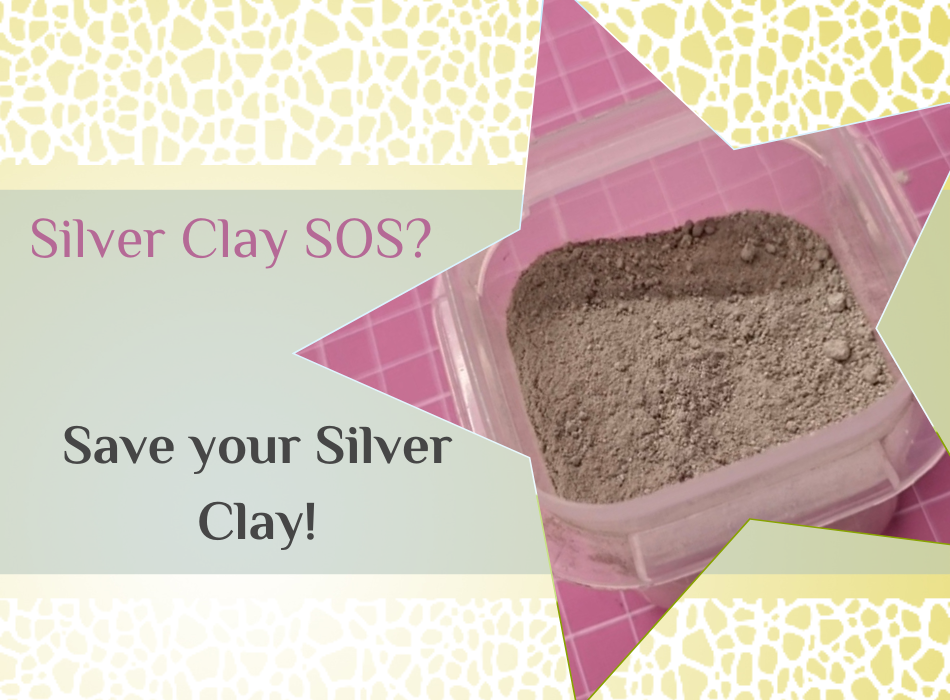How do you save your Silver Clay?
I am not talking about saving your clay for a rainy day. Or saving it once it’s opened – although that’s important and if you want some suggestions as to how to do that – check this blog out…
No, I am talking about saving your silver clay after you’ve rolled it out for the fifteenth time because you can’t get the texture right, it’s the wrong size or shape or it just hasn’t worked as expected. This blog post is for you if you need to save your silver clay from drying out during your creative time.
When you are just starting out working with Silver Clay it can be a little bit daunting. I tell my students this all the time! We expect when we get to adulthood that we can pick up most things, wing it and muddle through. That’s generally the case for a lot of things – I mean – how difficult is it to make soup or chicken curry if you have the basic ingredients right?
But when you are starting out on a new hobby – like silver clay for instance, despite it being, on the surface, a deceptively easy concept – you can run into difficulties quite quickly. Especially if you’re doing it on your own – or following a YouTube video which forgets to explain why you are doing what you’re doing.
Shameless plug for my course Alchemy – because you’re never in ANY doubt as to why I’m teaching you a certain thing. Everything is explained. You can find out more about that course here if you’d like to.
How to save your silver clay.
Fortunately, most brands of silver clay are quite forgiving, and you can bring them back to life with a little bit of TLC. I generally split the clay into three categories.
- Overworked,
- Crusty but still malleable and
- Dried out completely.
There’s an approach for each stage!
Save your Silver Clay when it’s overworked.
How do you spot overworked clay?
Your Silver Clay will look slightly marbled on the surface and may have some surface cracks and some frayed edges when you roll it out. It may also start curling at the edges or be difficult to work with.
How does it happen?
This overworking can happen for lots of different reasons – you’ve rolled it out many times, it’s been sitting in its pot or packaging for a while and not been used, the room is too warm or your hands are dry.
How to save your Silver Clay!
This is the simplest issue to tackle – saving your silver clay at the overworked stage requires a little water, a clean finger and a bit of patience.
- Make sure your work surface is clean and you have applied a tiny amount of release agent to it (a little bit of olive oil, some Badger Balm etc)
- Roll out your clay on your board to it’s thinnest. You don’t need cards or spacers for this.
- Once it’s flat, dip your finger into some clean water and apply to the surface of the clay.
- Rub it in gently. If the water disappears almost immediately, repeat the process oe or two more times. You are looking for the water to leave a sheen on top of the clay.
- Roll up your clay carefully – be aware that it may be a little sticky.
- Put it in some cling film (plastic food wrap) and pop it in an airtight pot and leave it for about 30 minutes for the water to fully absorb into the clay.
- Then use it as you need!
If you want to see a video – have a look here
Save your Silver Clay when it’s crusty but still malleable
How do you spot crusty Silver Clay?
This silver clay will feel quite hard, but if you press it, you can still squish it. It will be difficult to roll out and control.
How does this happen?
Usually it’s because the clay has been left in the open, or left too long in a pot without additional moisture (like a wet wipe).
How to save your Silver Clay!
Depending on how easily it can be rolled out, follow either instructions one or two.
If it can still be rolled out
Follow the instructions above. You will more than likely have to do this a number of times, but be patient, since it is worth the effort. If the Silver Clay is still looking a little bit tired, then you can add an equal amount of fresh clay to your older clay and knead this together thoroughly.
OR
If it can’t be rolled out but is still malleable
- Collect the pieces of clay together. Put in a piece of cling film (plastic food wrap) and add some water. You want to cover the clay in water, just don’t drown it! You can always add more water later.
- Knead the clay through the cling film to encourage the water to permeate the clay.
- Once it’s clumping together, remove the clay from the cling film and transfer to another clean piece of cling film.
- Knead the clay in the cling film to encourage the water to be absorbed.
- Put it in an airtight pot or into the bag it came in along side a wet wipe for moisture. Leave for 24 hours
- Once the 24 hours have passed, take the clay out of the cling film and have a look at it.
- If it looks dry – add some more water following the instructions above.
- Use as normal.
If you’d like to see a video – have a look here
Save your Silver Clay once dried completely
How do you spot dried clay
Your silver clay will be hard and have no malleability.
How does this happen?
It can happen because you have deliberately dried the clay out as part of creating something and the piece has broken. The clay has been left in the open, or left too long in a pot without additional moisture (like a wet wipe).
How to save your Silver Clay!
- Grind up your clay, using a designated coffee grinder, food processor or a mortar and pestle. Make sure it’s set aside for use with your silver clay only!
- Once the clay is in a powder form, pass it through a fine mesh sieve to make a finer powder. You can continue to grind up the larger lumps of clay and add to the mix or set them aside for reconstitution at a later date.
- Using a spray bottle, add some water to the silver powder. You want to add enough to cover the powder, but don’t add too much because it will make the silver almost impossible to handle. If you’ve added too much water, add some more silver powder to the mix.
- Take a pallet knife and start to mix the water and clay powder together.
- Once it starts to clump, start pressing the clay together. If it sticks easily, continue until you get a ball. If it doesn’t stick easily, add a small amount of water, little by little until it does.
- Once you have a ball that clumps together. Get a plastic document wallet and apply a layer of release agent. I usually use Cool Slip for this purpose but you could use olive oil or Badger Balm. You need the release agent at this point because the clay could be very sticky.
- Place the ball of clay in between the document wallet and roll the clay as thinly as you can.
- Have a look at the clay and examine the surface. Using your fingers add water to the surface. If the water absorbs quickly, roll back into a ball and repeat this step until the surface of the clay doesn’t absorb any more water – the surface should appear slick.
- Roll the clay back up into a ball. Wrap it into some cling film (plastic food wrap) and leave overnight.
- Use the clay as normal – bear in mind, it may need a little more water to refresh it from time to time – it will be drier than fresh clay out of the packet.
If you’d like to see a video, have a look here
Hope this blog helps you and gives you confidence when working with Silver Clay. The great thing is, that most situations can be salvaged!
Have fun!
Love, Emma x







Should we use distilled water rehydrating?
Thanks!
Yes, it’s a good idea to do so, especially if you have hard water in your area.